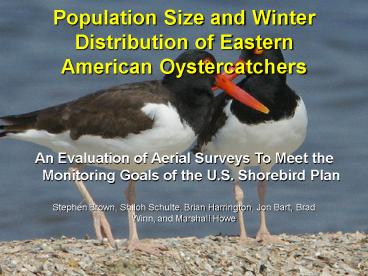Coastal Bird Conservation Network - PowerPoint PPT Presentation
1 / 26
Title:
Coastal Bird Conservation Network
Description:
National Audubon Society. New Jersey Audubon Society. Audubon North Carolina. Audubon of Florida. Houston Audubon Society. Cape Romain National Wildlife Refuge ... – PowerPoint PPT presentation
Number of Views:145
Avg rating:3.0/5.0
Title: Coastal Bird Conservation Network
1
Population Size and Winter Distribution of
Eastern American Oystercatchers
An Evaluation of Aerial Surveys To Meet the
Monitoring Goals of the U.S. Shorebird Plan
Stephen Brown, Shiloh Schulte, Brian Harrington,
Jon Bart, Brad Winn, and Marshall Howe
2
American Oystercatcher
U.S. Shorebird Plan
- Population size estimate 7500 birds, high risk
due to low number - Conservation needs
- Survey wintering population
- Band resighting study to determine migration
patterns - Determination of high priority habitat
- Coordinated efforts required AMOY working
group formed
3
American Oystercatcher
Category High Priority Focal species
Beachfront Population Trend 3 Relative
Abundance 5 Threats Breeding 4 Threats
Non-breeding 4 Breeding Distribution
3 Non-breeding Dist. 4
Population Estimates Current Target Haematopus
palliatus 7,500 ? (Status unknown) Low
population, vulnerable to wintering habitat loss
4
(No Transcript)
5
Range of the American Oystercatcher
From Nol and Humphrey 1994
6
International Shorebird Survey Sites Atlantic
and Gulf Coasts
Coastal coverage is considerable, but data
from many sites is limited
7
BCR 30 New-England/ Mid-Atlantic Coast
American Oystercatcher Survey Coverage
BCR 27 Southeastern Coastal Plain
BCR 31 Peninsular Florida
BCR 37 Gulf Coastal Prairie
8
American Oystercatcher Survey Methods
- Estimates of flock size
- Stratified sampling
- Aerial photography (Digital SLR, 6.1 MP, 300 mm
image stabilized lens) for detection rate within
flocks - Ground counts for flock detection rates
- Survey window High Tide /- 2 Hours
- Videography tests
9
Survey Zones
- High quality habitat types
- Known roost sites
- Shell rakes, sand spits, etc.
- Complete survey of all locations identified
- Intertidal marsh habitats
- States, broken into blocks
- Random subsample surveyed completely
- Barrier beach habitats
- Survey all in random blocks
- Survey all other areas opportunistically
10
Strata Used to Estimate Population Size
- Flocks in high-quality habitat counted on the
ground or in photographs - No sampling error
- Flocks in high-quality habitat counted visually
from the air - Detection rate for birds in flocks
- Flocks on barrier beaches
- Detection rate for flocks
- Detection rate for birds in flocks
- Flocks in low-quality habitat
11
Detection Rates
- Detection rate for flocks
- Calculated from ground counts
- Applied to high quality habitat areas with no
ground counts - Detection rate for birds within flocks
- Calculated with photographs
- Applied to high quality habitat area flocks with
no photograph
12
American Oystercatcher Survey Zones
13
(No Transcript)
14
(No Transcript)
15
(No Transcript)
16
(No Transcript)
17
(No Transcript)
18
(No Transcript)
19
American Oystercatcher Roost Site Locations From
Aerial Surveys
20
Survey Coverage by State
21
Detection Rate Flock Size Estimates
R20.9761
N87
Mean Estimate/Count0.91 (SE 0.002)
22
Detection Rates Flocks
23
Numbers of Birds Recorded By State
24
Population Estimate for Eastern American
Oystercatchers
Final Population Estimate 10,971 298
25
Oystercatcher Roost Site Habitat Use and
Availability
26
Acknowledgments
- USGS SSP Program
- USFWS Region 5
- Atlantic Coast Joint Venture
- National Fish and Wildlife Foundation
- Scott Johnston, Andrew Milliken
- Catherine Wightman
- Ground count crews Barry Truitt, Alex Wilke,
Felicia Sanders, Nancy Douglas, David Allen,
Amanda Dey, David Mizrahi
27
Acknowledgments, contd
New Jersey Division of Fish and Wildlife Virginia
Department of Game and Inland Fisheries North
Carolina South Carolina Department of Natural
Resources Georgia Department of Natural
Resources Florida Fish and Wildlife
Commission Alabama Wildlife and Freshwater
Fisheries Division Texas Parks and Wildlife The
Nature Conservancy National Audubon Society New
Jersey Audubon Society Audubon North
Carolina Audubon of Florida Houston Audubon
Society Cape Romain National Wildlife
Refuge Grand Bay National Estuarine Research
Reserve































